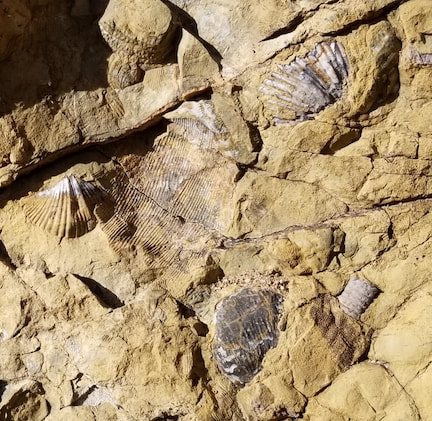As rocks weather, they break up into pieces of different sizes, which, when mobilized by water, wind, or ice, we called clastic sediment. As these fragments are transported, they are ground down further. Moving water or blowing wind can sort sediment into separate accumulations of mud or sand. But we are overlooking something.
Weathering also releases dissolved chemical elements into the streams and groundwater. Most of this invisible material is carried to the ocean.
Various natural processes, some inorganic, some biological, find ways to turn these dissolved chemicals back into sediment.
In terms of sheer volume, the most important of these chemical sediments is a chalky substance called calcium carbonate. Calcium carbonate is the precursor to lime, calcium oxide, which we use in cement, concrete, stucco, and many chemical processes.
Sea water is very nearly saturated in calcium carbonate, and in warm shallow seas made alkaline by flourishing marine life, it comes out of solution to form a pale-colored mud. Lime-secreting algae stiffen their leaves with calcium carbonate, which is released as tiny particles when they decay. Corals and shellfish build rigid homes out of calcium carbonate, contributing sand-sized particles when they die and their skeletons disintegrate.
By this endless living and dying, great banks and reefs of lime sediment can accumulate in warm, clear, shallow seas. These carbonate muds and sands are soon cemented into the third most common sedimentary rock, limestone.
The marine environment of this limestone is clearly revealed by the fossils of invertebrate sea creatures that it contains:
Weathering also releases dissolved chemical elements into the streams and groundwater. Most of this invisible material is carried to the ocean.
Various natural processes, some inorganic, some biological, find ways to turn these dissolved chemicals back into sediment.
In terms of sheer volume, the most important of these chemical sediments is a chalky substance called calcium carbonate. Calcium carbonate is the precursor to lime, calcium oxide, which we use in cement, concrete, stucco, and many chemical processes.
Sea water is very nearly saturated in calcium carbonate, and in warm shallow seas made alkaline by flourishing marine life, it comes out of solution to form a pale-colored mud. Lime-secreting algae stiffen their leaves with calcium carbonate, which is released as tiny particles when they decay. Corals and shellfish build rigid homes out of calcium carbonate, contributing sand-sized particles when they die and their skeletons disintegrate.
By this endless living and dying, great banks and reefs of lime sediment can accumulate in warm, clear, shallow seas. These carbonate muds and sands are soon cemented into the third most common sedimentary rock, limestone.
The marine environment of this limestone is clearly revealed by the fossils of invertebrate sea creatures that it contains:
Although their volumes are not as great, other chemical and organic sediments help form the backbone of our modern industrial societies. Sea water evaporates into beds of rock salt, a source of table salt, sodium, and chlorine. Saline lagoons evaporate into gypsum, the basis of plaster and a source of sulfur. Under special conditions, swamps and marshes accumulate stupendous masses of undecayed plant matter, which, when buried, compresses into coal, nearly pure carbon. For better or worse, coal is still an important fuel, and it is critical in steel making.
What all these sediments have in common is a relatively simple and pure chemical composition. In creating these sediments, nature has done nearly all the work of refining crustal material into substances man can use.
What all these sediments have in common is a relatively simple and pure chemical composition. In creating these sediments, nature has done nearly all the work of refining crustal material into substances man can use.


 RSS Feed
RSS Feed
